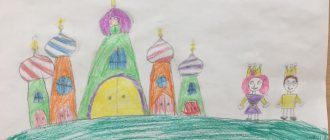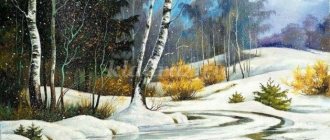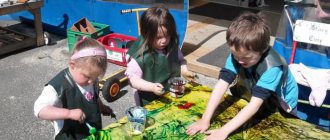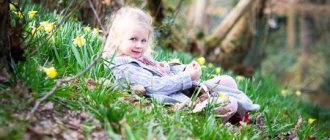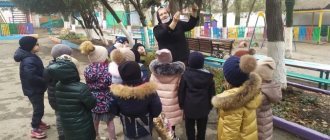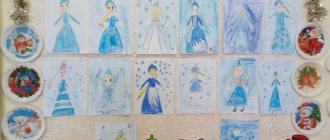Autumn walk “Observing flowers in a flowerbed” in the preparatory group. Abstract
Summary of the educational walk “Autumn Flowerbed”.
Preparatory group Author : Lyudmila Ivanovna Frolkova, teacher, MBDOU "Kindergarten No. 118", Dzerzhinsk, Nizhny Novgorod region Description: Summary of an educational walk in the fall with children of the preparatory group. It will be useful for educators and parents. Designed for children of senior preschool age. Can be used in a special moment, during a day walk with children. Goal : developing ideas about seasonal changes in nature; knowledge about flowering plants in flower beds, classifying them, the need to transplant indoor flowers (geranium and balsam) from flower beds into pots for further growth in the group, their significance for humans and the need for respect for nature. Objectives: - expand knowledge: about the names of flowers, about their structure; conditions necessary for development; - introduce a new concept - “perennial” and “annual” flowers; — consolidate the ability to remove dried plants in the flower garden and collect seeds; - strengthen children’s ability to classify and name indoor, garden and meadow flowers. - develop children's interest, curiosity and cognitive motivation. - develop and improve children’s motor skills and abilities - develop strength, endurance, reaction speed in games; - promote the development of communication and interaction of the child with peers and adults. - make children want to work: collect seeds, replant flowers in pots. Enriching the vocabulary: annual, perennial, indoor, garden, meadow, marigold, petunia, zinnia, hosta, primrose, fern, balsam, geranium. Preliminary work: looking at paintings from the series “Garden Flowers”, “Meadow Flowers”, looking at indoor flowers, guessing riddles, reading poetry. Materials and equipment: flower bed on the site, boxes for collecting seeds, pots with soil, scoops.
Progress of the walk
With the children of the preparatory group we go out for a walk in our area.
Guys, let's remember what time of year it is?
(autumn)
.
What signs of autumn do you know? (it’s raining, the sky is gloomy, it’s getting cold, the leaves on the trees change color and fall, the flowers are fading)
That’s right, golden autumn has come with its unique beauty in the decoration of trees and flowers!
You and I planted flowers in the flowerbed in the spring. Why do people plant flowers, do you think? (flowers make you happy and improve your mood)
.
Is it possible to pick flowers from a flower bed? (it’s better not to tear, but to look and admire)
.
Listen to the poem: If I pick a flower, If you pick a flower, If everything: both me and you, If we pick flowers, All the meadows will be empty and there will be no beauty. (T. Sobakin)
And how has our flowerbed changed with the arrival of autumn, let’s see?
(we approach the flowerbed)
.
Let's remember what flowers grow in our flowerbed?
(annual and perennial)
.
What perennial flowers grow and why are they called that? (perennials are not planted in the spring, they overwinter in the soil)
Why do they overwinter in the ground and not die?
(the root grows deep in the ground)
.
What perennials grow here? (primrose, hosta, fern)
.
Well done, why are annual flowers called that? (grow from spring to autumn, cannot overwinter)
.
What flowers did we plant in our flowerbed in the spring? (petunias, marigolds, zinnias)
.
What can you say about them, how they changed by autumn?
(bloomed, withered, withered)
.
What other flowers did we plant in the spring? (geranium, balsam)
.
That's right, geranium and balsam tolerate transplantation very well. They are very comfortable growing in a flower bed. Look how lush the geranium is and how profusely it blooms! The balsam also feels great, the bush is simply unrecognizable! But it’s time for these flowers to return to the group, to the windowsill and continue to delight us with their flowering. What do we need for transplantation? (pots with soil, scoop)
Together we replant flowers, accompanied by a detailed description)
Well done, guys, they did a great job!
Listen to the poem: Long live flowers of all types, all colors - and bright beauty. And hidden between the branches... Long live the flowers! All, all of them are beautiful! (Sh. Mgshvili)
Guys, what do you think we need to do with the flowers that have already bloomed and withered?
(collect seeds, remove from flowerbed)
.
Let's do this, take the boxes and collect them together to sow them again in the spring. What about wilted flowers? (dig up with the roots)
That's right guys, we'll dig them up and take them to the site, where we take the leaves, so that by spring we can get humus and plant flowers again!
We did a great job with you! Let's go to the veranda and play the game “I was born a gardener.”
We recommend watching:
Synopsis of a comprehensive lesson for children of the preparatory group on the topic: Autumn Synopsis of the educational instruction in drawing for children of the preparatory group of a preschool educational institution. Autumn rowan GCD on cognitive development in the preparatory group on the topic “Autumn” Summary of SOD in the preparatory group on the topic: Autumn
Similar articles:
Summary of an autumn walk in the preparatory group “Observing a sparrow in autumn”
Summary of an autumn walk in the preparatory group “Observing pigeons”
Summary of a walk in the preparatory group “Observing a poplar”
Summary of the walk in the preparatory group “Observing seasonal changes in November”
Summary of the walk in the preparatory group “Observation of coniferous and deciduous trees in autumn”
Summary of an autumn walk in the preparatory group of a preschool educational institution
- April 6, 2016
Competition “Methodological piggy bank of a teacher - 2016”
Nomination “Methodological piggy bank of a preschool teacher”
Main stages of the walk:
1. Observations in nature.
2. Outdoor game.
3. Individual work (in subgroups).
4. Role-playing game.
5. Labor activity on the site.
Take-out materials: balls, crayons, equipment for playing with sand, brooms, rakes, garbage bags.
The progress of the autumn walk in the preparatory group of the preschool educational institution
1. Observations in nature.
Goal: to summarize and systematize children’s knowledge about autumn as a season; combine familiarization with seasonal changes in nature with the formation of aesthetic ideas; develop cognitive interest, thinking, memory, speech, attention.
– Guys, today we will take a walk around the territory of our kindergarten. Let us begin our journey with wonderful verses:
The rain is pouring, cold as ice, the leaves are spinning in the clearings, and the geese are flying in a long caravan over the forest.
– What time is spoken about in Ivan Bunin’s poem? (About autumn).
– What autumn months do you know? Name them. (Children's answers).
– What do people call September, October and November and why? (Children's answers).
– Let’s all remember the proverbs about autumn:
- Thunder in September - for a warm autumn.
- Late leaf fall means a harsh winter.
- There is no turn from autumn to summer.
- In September, even a leaf does not stick to the tree.
- There is no September without fruits.
- September is cold and full.
- October alternately cries and laughs.
- September smells like apples, October smells like cabbage.
- In November, winter and autumn are fought.
– Now let’s see if you can solve autumn riddles:
1) She came without paints and without a brush and repainted all the leaves..... (autumn. Draw the children’s attention to the foliage of the trees, note the color palette of autumn).
2) Leaves are falling from the aspen trees. A sharp wedge is rushing in the sky...... (a flock of cranes)
3) In the spring they grow, fall into the canopy………(leaves)
- Well done guys, you solved the riddles easily. And now I’ll tell you a little about folk signs. All of them were noticed by the people on the basis of constant observations of the life of nature:
- There are a lot of rowan trees - autumn will be rainy.
- The clouds are low - expect cold.
- If the leaves, falling off, lie with the wrong side up, it means a warm winter, with the front side up, it means a cold winter.
- Let's check what kind of winter we can expect. (Children consider the position of the leaves and draw conclusions. If opinions are divided, bring the children to the fact that the position of the leaves can change due to the wind).
- Guys, do you think we can check this sign? How? (Children's answers).
2. Outdoor game.
Goal: to develop dexterity, speed, coordination of movements, attention; develop the ability to play in a team, give in to each other; foster a sense of camaraderie; follow the rules of the game; develop speech and memory.
– In autumn it gets cool outside, so to keep us warm, we’ll play a game together. (We offer a choice of games “Mousetrap”, “Third Wheel”, “Trap”, “Find Yourself a Mate”).
3. Individual work (in subgroups).
Goal: overcoming shyness, developing observation, speech, mental abilities; practicing basic movements, developing moral qualities. One subgroup does math tasks (you can use crayons), the second subgroup plays “Dodgeball” with a ball or does exercises with balls individually or in pairs.
4. The role-playing game is chosen at the request of the children.
Goal: to create and maintain a calm, friendly environment during the game, to provide children with the opportunity to engage in activities that interest them; pay attention to withdrawn, shy children, help them find their place in the game; Involve overly excited children in activities that would help calm them down. (“Ice Cream Parlor”, “Fortress Builders”).
5. Labor activity on the site.
Goal: teach children to work with tools (rakes, brooms), teach them to work in a team, help each other; appreciate your work and the work of your comrades, learn to negotiate on controversial issues; be able to see and appreciate the results of your work; respect the work of the janitor.
- Guys, look how many leaves we have on our site. Let's put things in order here. (Give the children a tool, give a specific task. Summarize the work, praise the children for their diligence and hard work).
- And now for everyone who worked and was tired, lunch hour has come!
(Organized group care).
Author: Lyudmila Vladimirovna Kurchanova, teacher, MKDOU No. 13, Nizhneudinsk.
